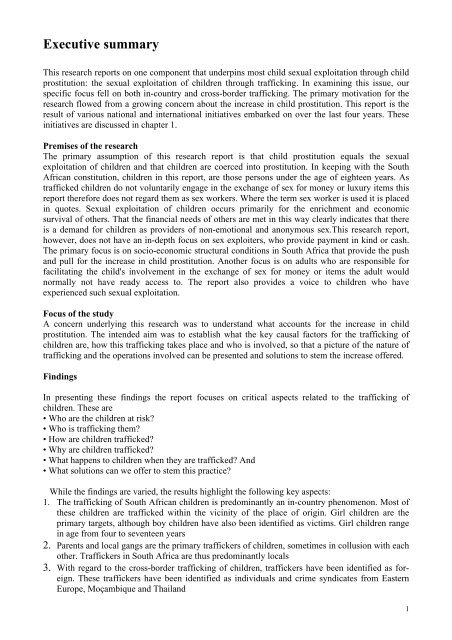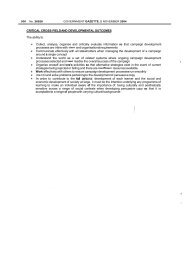The trafficking of children for purposes of sexual exploitation
The trafficking of children for purposes of sexual exploitation
The trafficking of children for purposes of sexual exploitation
You also want an ePaper? Increase the reach of your titles
YUMPU automatically turns print PDFs into web optimized ePapers that Google loves.
Executive summary<br />
This research reports on one component that underpins most child <strong>sexual</strong> <strong>exploitation</strong> through child<br />
prostitution: the <strong>sexual</strong> <strong>exploitation</strong> <strong>of</strong> <strong>children</strong> through <strong>trafficking</strong>. In examining this issue, our<br />
specific focus fell on both in-country and cross-border <strong>trafficking</strong>. <strong>The</strong> primary motivation <strong>for</strong> the<br />
research flowed from a growing concern about the increase in child prostitution. This report is the<br />
result <strong>of</strong> various national and international initiatives embarked on over the last four years. <strong>The</strong>se<br />
initiatives are discussed in chapter 1.<br />
Premises <strong>of</strong> the research<br />
<strong>The</strong> primary assumption <strong>of</strong> this research report is that child prostitution equals the <strong>sexual</strong><br />
<strong>exploitation</strong> <strong>of</strong> <strong>children</strong> and that <strong>children</strong> are coerced into prostitution. In keeping with the South<br />
African constitution, <strong>children</strong> in this report, are those persons under the age <strong>of</strong> eighteen years. As<br />
trafficked <strong>children</strong> do not voluntarily engage in the exchange <strong>of</strong> sex <strong>for</strong> money or luxury items this<br />
report there<strong>for</strong>e does not regard them as sex workers. Where the term sex worker is used it is placed<br />
in quotes. Sexual <strong>exploitation</strong> <strong>of</strong> <strong>children</strong> occurs primarily <strong>for</strong> the enrichment and economic<br />
survival <strong>of</strong> others. That the financial needs <strong>of</strong> others are met in this way clearly indicates that there<br />
is a demand <strong>for</strong> <strong>children</strong> as providers <strong>of</strong> non-emotional and anonymous sex.This research report,<br />
however, does not have an in-depth focus on sex exploiters, who provide payment in kind or cash.<br />
<strong>The</strong> primary focus is on socio-economic structural conditions in South Africa that provide the push<br />
and pull <strong>for</strong> the increase in child prostitution. Another focus is on adults who are responsible <strong>for</strong><br />
facilitating the child's involvement in the exchange <strong>of</strong> sex <strong>for</strong> money or items the adult would<br />
normally not have ready access to. <strong>The</strong> report also provides a voice to <strong>children</strong> who have<br />
experienced such <strong>sexual</strong> <strong>exploitation</strong>.<br />
Focus <strong>of</strong> the study<br />
A concern underlying this research was to understand what accounts <strong>for</strong> the increase in child<br />
prostitution. <strong>The</strong> intended aim was to establish what the key causal factors <strong>for</strong> the <strong>trafficking</strong> <strong>of</strong><br />
<strong>children</strong> are, how this <strong>trafficking</strong> takes place and who is involved, so that a picture <strong>of</strong> the nature <strong>of</strong><br />
<strong>trafficking</strong> and the operations involved can be presented and solutions to stem the increase <strong>of</strong>fered.<br />
Findings<br />
In presenting these findings the report focuses on critical aspects related to the <strong>trafficking</strong> <strong>of</strong><br />
<strong>children</strong>. <strong>The</strong>se are<br />
• Who are the <strong>children</strong> at risk?<br />
• Who is <strong>trafficking</strong> them?<br />
• How are <strong>children</strong> trafficked?<br />
• Why are <strong>children</strong> trafficked?<br />
• What happens to <strong>children</strong> when they are trafficked? And<br />
• What solutions can we <strong>of</strong>fer to stem this practice?<br />
While the findings are varied, the results highlight the following key aspects:<br />
1. <strong>The</strong> <strong>trafficking</strong> <strong>of</strong> South African <strong>children</strong> is predominantly an in-country phenomenon. Most <strong>of</strong><br />
these <strong>children</strong> are trafficked within the vicinity <strong>of</strong> the place <strong>of</strong> origin. Girl <strong>children</strong> are the<br />
primary targets, although boy <strong>children</strong> have also been identified as victims. Girl <strong>children</strong> range<br />
in age from four to seventeen years<br />
2. Parents and local gangs are the primary traffickers <strong>of</strong> <strong>children</strong>, sometimes in collusion with each<br />
other. Traffickers in South Africa are thus predominantly locals<br />
3. With regard to the cross-border <strong>trafficking</strong> <strong>of</strong> <strong>children</strong>, traffickers have been identified as <strong>for</strong>eign.<br />
<strong>The</strong>se traffickers have been identified as individuals and crime syndicates from Eastern<br />
Europe, Moçambique and Thailand<br />
1
















